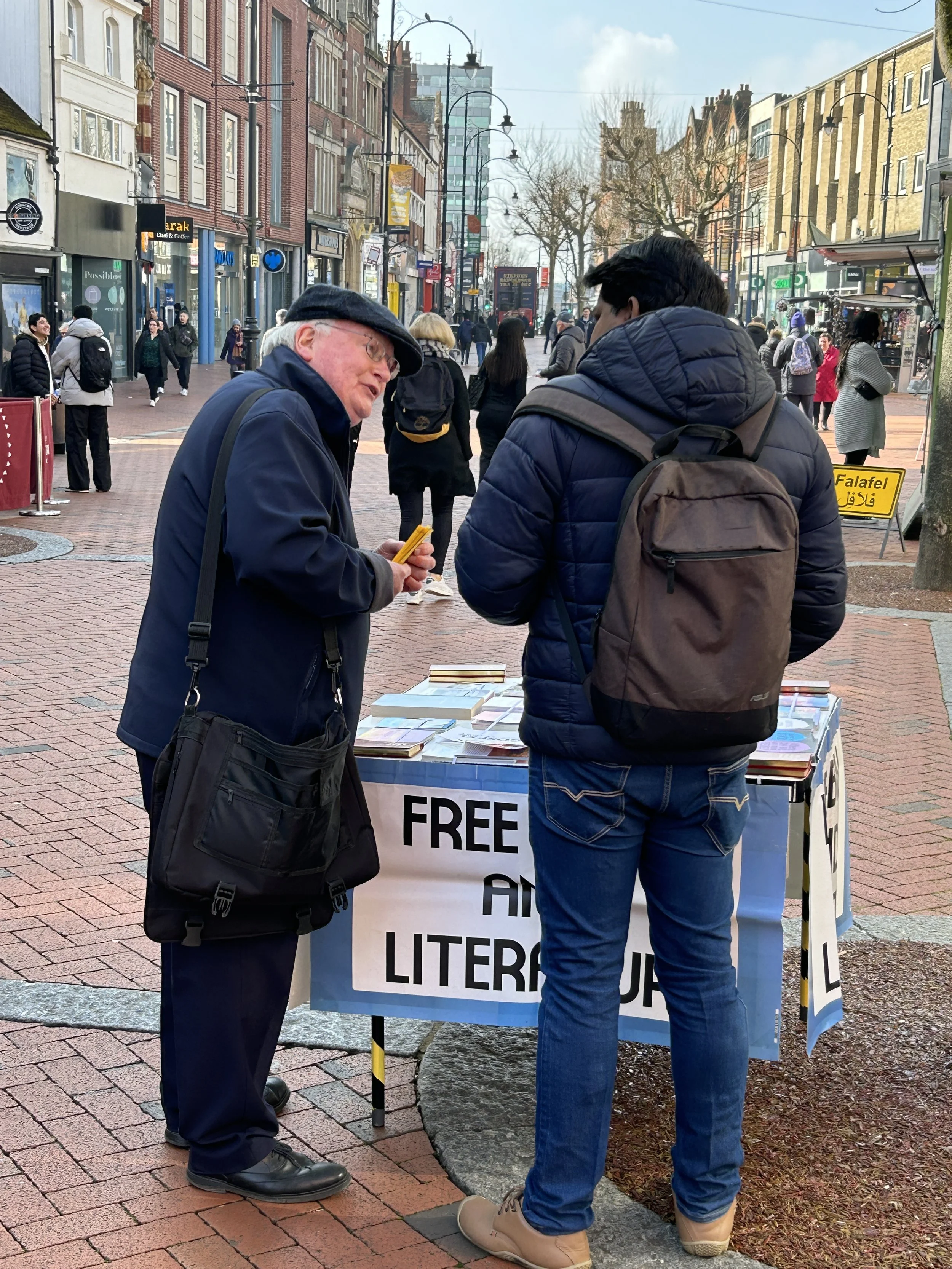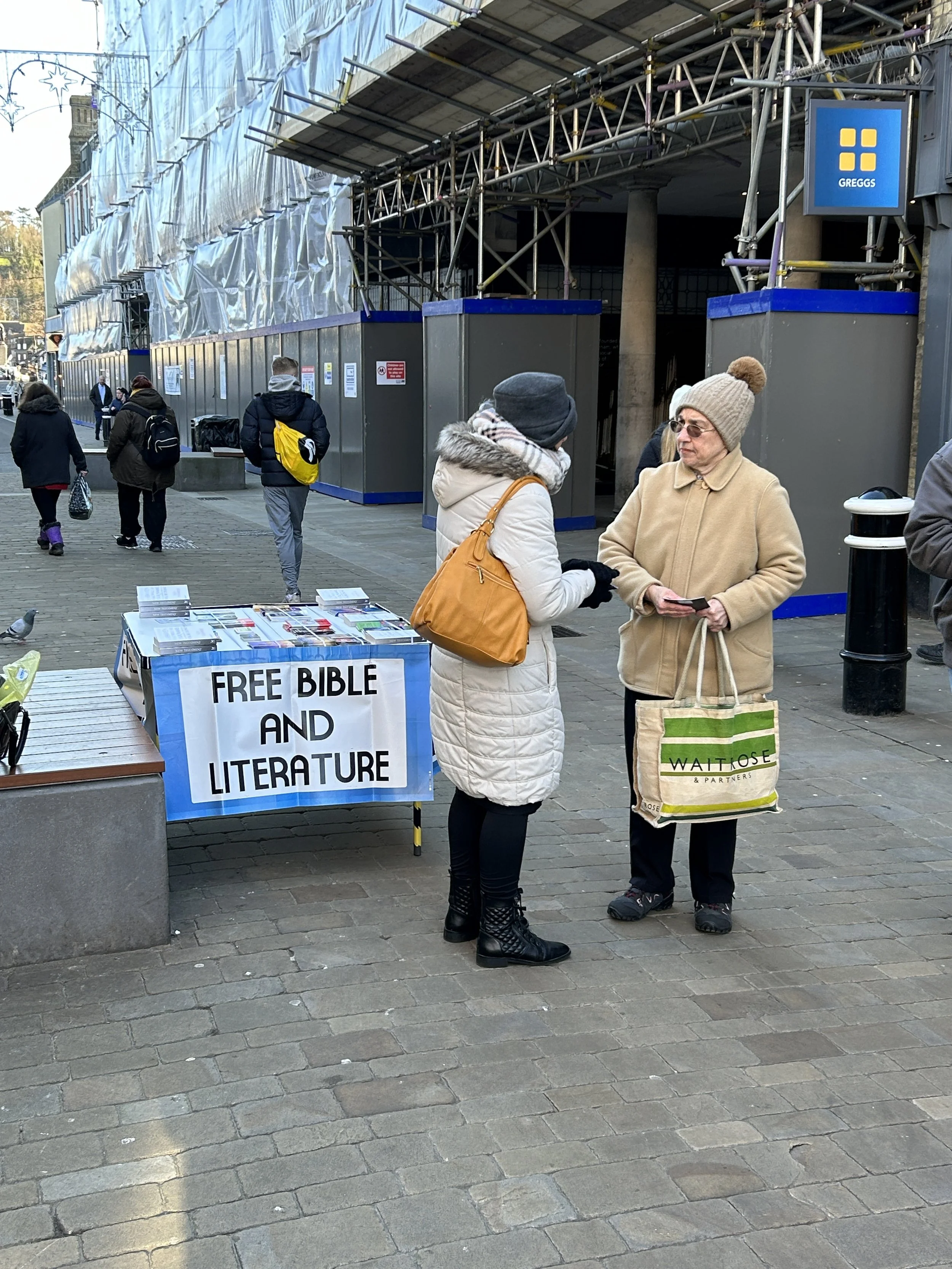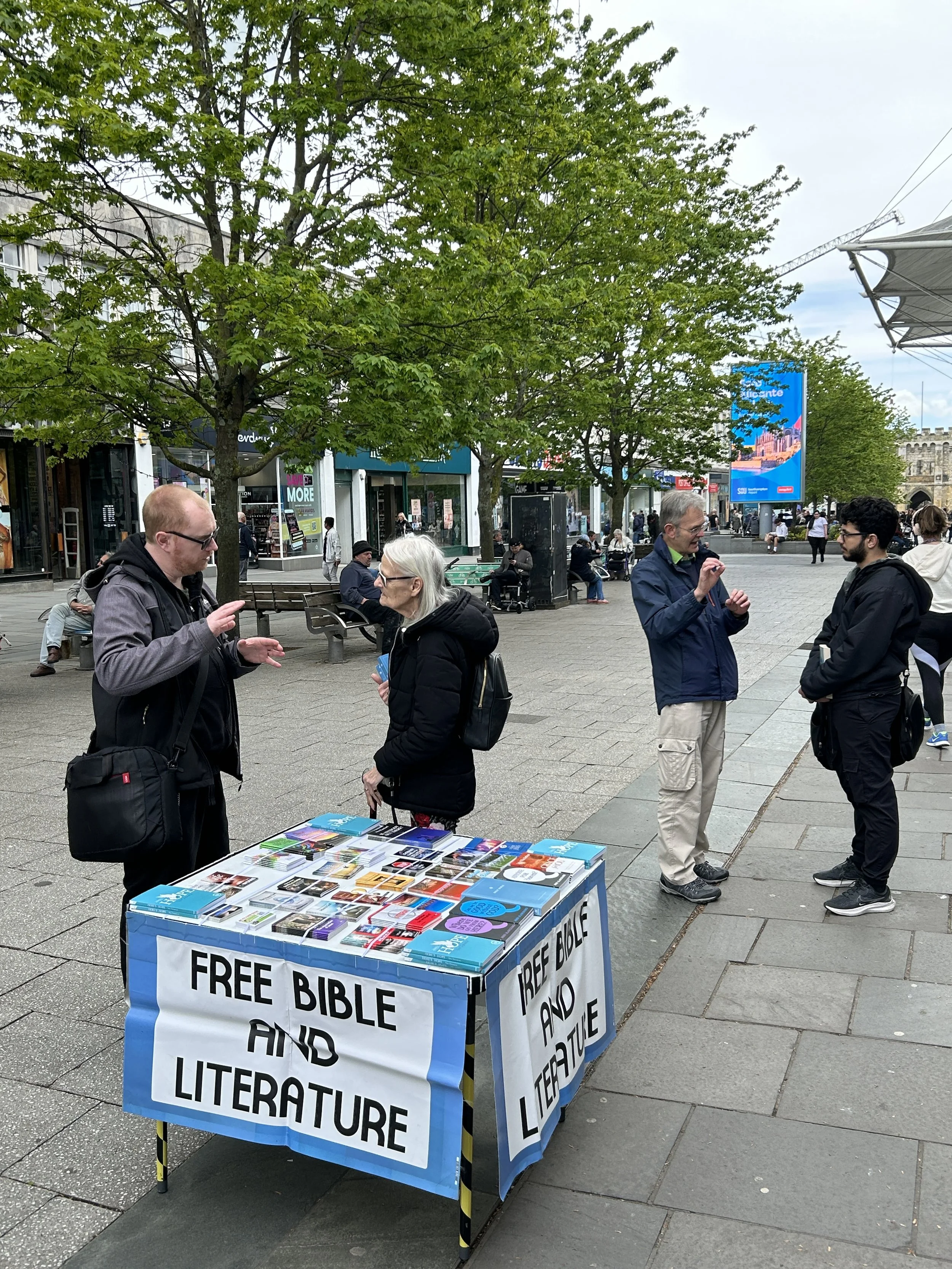The Use of a Literature Table
For the past 20+ years, I have ensured the use of a literature table at most of our evangelistic outreaches. This straightforward approach to gospel ministry has been instrumental in distributing thousands of Christian booklets, Bibles, and New Testaments. The table has also served as a magnet, attracting people to engage in conversations about the good news.
I have used the literature table in large and bustling cities as well as in small country villages. In every location, the Lord has blessed the work and used this method of evangelism. I am firmly convinced of the effectiveness of this outreach method and would encourage you to consider how you might set up your own literature table.
How to Set Up a Table
1. Purchase a Folding Table:
It should go without saying, but the first step in establishing this form of evangelism is to have a table! You’ll want to find a table that folds down and is easy to carry, but at the same time, it needs to be sturdy. Some lightweight tables don’t fare well in the wind, and with regular use, they can weaken. Look for something foldable, sturdy, and not too heavy.
2. Safety:
Once you have your table, ensure it is safe to use. Since this outreach takes place in public spaces, I recommend wrapping the legs in yellow and black safety tape. This added level of protection will help if someone ever trips over your table. Make sure the table is highly visible – we want to prioritise people’s safety.
3. Signs:
If you want people to stop at the literature table, you need to ensure it is clearly signed. I have seen some tables with a small A5 or A4 sign attached to the side. These signs aren’t readable until you’re standing next to the table, causing people to pass by without a second glance. To attract attention, clearly indicate the purpose of your table. My table, for instance, has a large sign on each side stating, “FREE BIBLE AND LITERATURE.” I opted for a blue border around the signs to make them eye-catching. Your signs should be easy to see and read.
4. Velcro (hook-and-loop):
To attach your signs to the table, I recommend purchasing heavy-duty Velcro. Place one side on the back of the signs and the other on the table. This method is both secure and convenient, making it quick and easy to set up and pack away.
5. Elastic Straps:
One of the biggest challenges with a literature table is wind. Over the years, I’ve experimented with various ways to secure booklets in place. After numerous trial-and-error efforts, my wife suggested a brilliant solution (I should have asked her advice sooner!). She recommended thin elastic straps with Velcro ends, which could attach to the same Velcro used for the signs. The signs can then be placed over the straps. Since adopting this approach, I’ve only needed to replace the stretched elastic about once a year, and I no longer have to chase booklets and tracts around busy city centres when it’s windy.
6. Location:
Once your table is ready to hit the streets, choose a location with plenty of space. Avoid blocking pathways or obstructing traffic. Look for an open area that accommodates your table and allows people to stop without causing disruption. If you plan to set up on private property, ensure you obtain the owner’s permission first.
7. Carrying Equipment:
You’ll need to transport both your table and resources to the outreach location. I suggest using a hard plastic box to store your resources, which can then be placed in a backpack/rucksack or carried separately. Most folding tables have a handle, but depending on the table’s weight, this might limit how far you can carry it. A small folding trolley with straps to secure the table makes transporting your equipment much easier.
Resources for a Literature Table
An empty table isn’t going to reach anyone for Jesus, so you need to have good resources available for people to take.
1. Bibles:
Since you are advertising “Free Bibles,” you need to have Bibles on hand. Of course, you will be limited in how many you can carry, but it’s recommended to have at least one or two full Bibles with you.
2. New Testaments:
Small New Testaments are easy to carry, so I always have at least ten copies on the table. During an outreach, these are usually taken by those who are interested in learning more about Christianity.
3. Gospels:
I always include copies of John’s Gospel on the table (though other Gospels work well too). These are especially useful if you’ve had a conversation with someone who wants to think further but isn’t ready to commit to reading a full Bible or New Testament. A simple pocket-sized edition of a Gospel is easy to hand out, enabling people to read the good news at their own pace.
4. Evangelistic Booklets:
Since your sign says “Literature,” it’s worth including more substantial booklets or books on the table. I use a variety of materials, such as gospel booklets from John Blanchard. An in-depth booklet should provide a clear explanation of the gospel. These booklets are more detailed than tracts, so those who take them often show an interest in learning more about Christianity.
5. Apologetic Booklets:
Over time, you’ll notice the common questions people tend to ask. Find high-quality booklets that address these questions while also presenting the gospel. Many times, individuals who are initially antagonistic towards the gospel will take a booklet on a topic they find intriguing. This can help answer their questions and introduce them to the good news in a thoughtful way.
6. Church Details:
Always include invitations and cards for local biblical churches. It’s important not just to share the gospel but also to encourage people to connect with a local church community.
7. Foreign Language Resources:
Depending on your location, you may find it helpful to have materials in different languages. On my table, I include cards linking to the gospel in numerous languages. I also carry booklets in around thirty different languages, though I keep these in my bag and hand them out only when needed.
Additionally, nearly all the materials on my table include a sticker with my contact details. This gives people the opportunity to follow up, ask questions, or connect with a biblical church.
For more information on where to buy resources (or obtain free materials), please refer to the article titled “Helpful Resources for Evangelism.”
Practical Tips for Using a Literature Table
1. Don’t Scare Away the Fish:
When someone goes fishing, they try to avoid doing anything that scares away the fish. The same is true when using a literature table. Once you’ve set up the table, give it some space. Don’t stand right next to it (or worse, sit on a chair behind it). Let the table stand on its own. This allows people to stop and browse without feeling pressured by a high-pressure sales pitch. If someone stops, let them look at the materials before walking over to greet them. Emphasise that everything is free and ask if there’s any topic that interests them. The way they respond will indicate whether they’re open to a gospel conversation or if they’re simply happy to browse. If they don’t want to talk, gently remind them that it’s free, and step away again.
2. Keep it Neat and Tidy:
I’ve seen tables so disorganised that it was impossible to know what was on offer. Keep your table well-ordered and tidy, with the materials clearly visible (and the right way up). Throughout the day, straighten the literature to make it easy for people to browse. It’s essential that people can see the titles of the booklets so they feel encouraged to take them.
3. Don’t Use the Table for Storage:
A personal pet peeve of mine is when a well-meaning Christian uses the table to store their drink or lunch. The table isn’t there for you to eat at! Cluttering the table with personal items makes it look untidy and uninviting. Similarly, if someone is preparing to preach, the table shouldn’t be used to hold a Bible or notes. Find a bench or another location for that. Keep the table clean and functional.
4. Less is More:
Over the years, I’ve discovered that sometimes less is more when it comes to literature tables. Try to limit the resources you display. Aim to have a full table, but leave some space between the booklets. Avoid overloading the table to the point where people feel overwhelmed by too much choice and don’t know where to begin.
The use of a literature table is an effective way of reaching the lost. Even if someone doesn’t approach the table, it serves as a silent reminder to all who pass by that Christians are out sharing the good news. In time, those who initially ignore the table may end up stopping to chat.
I’m reminded of one lady in Australia who hated our literature table. Every time she walked past, she would curse at us and tell us to leave. We remained pleasant and polite towards her. One week, we had free Bible colouring books for children. As she walked past cursing, she noticed the colouring books, stopped, and asked if she could take a couple for her kids. We gladly gave her some, and she left with a few less curses. The following week, she passed by without saying a word. A week later, she stopped to ask for a Bible. From that point on, she was very friendly.
You never know how the Lord will use a literature table. I encourage everyone to consider this effective form of gospel outreach.
For more guidance on using a literature table or to speak to someone about printing signs for your table, please click on the following links:
“5 reasons to use a free Christian literature table in outreach”
“The great commission: Everything you need to know about literature tables”
_____
Josh receives his salary from The Open-Air Mission. Any financial contributions made through this website will be allocated towards supplying evangelistic resources and addressing requirements associated with gospel-related activities.




